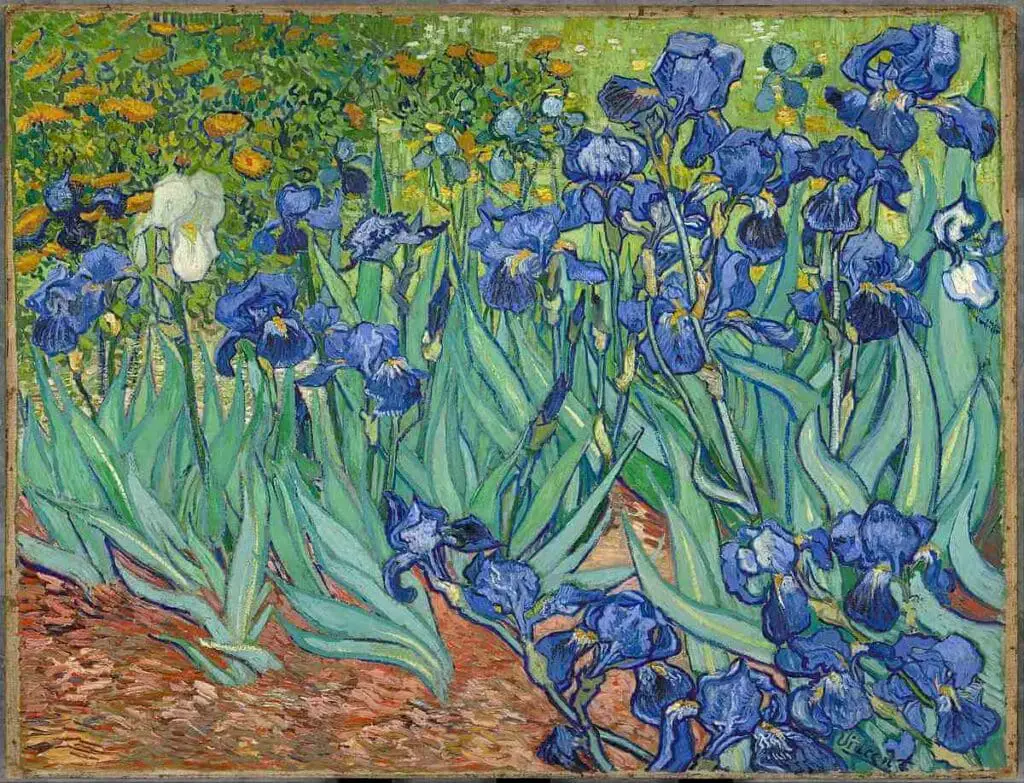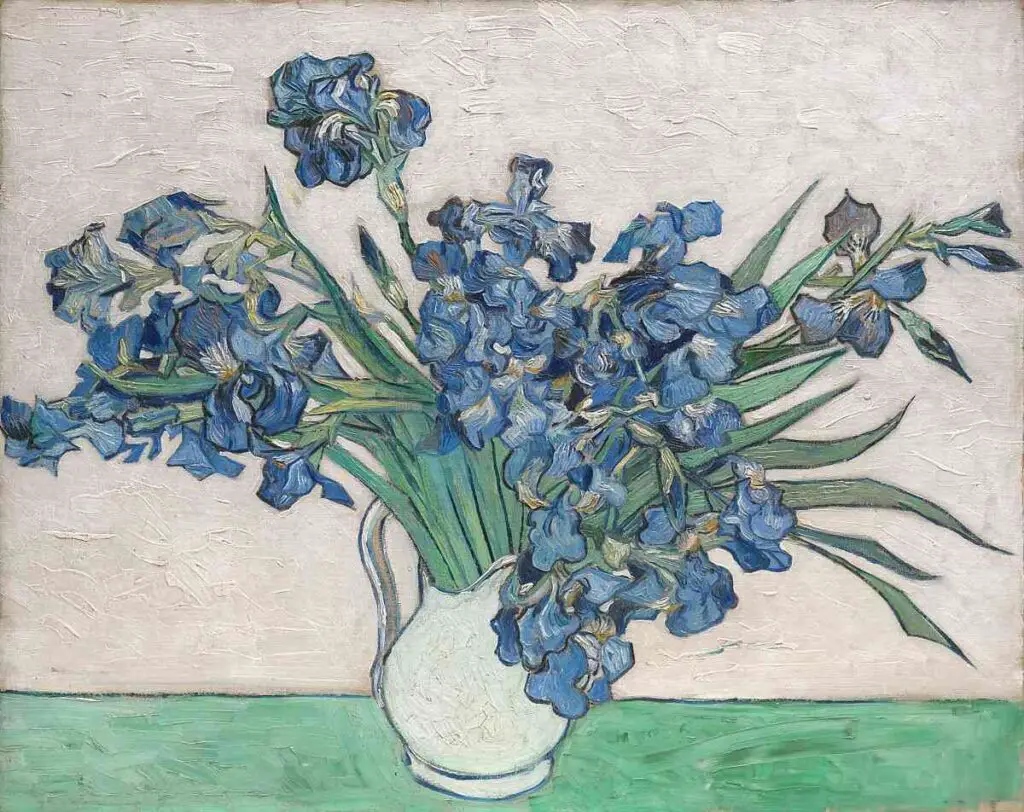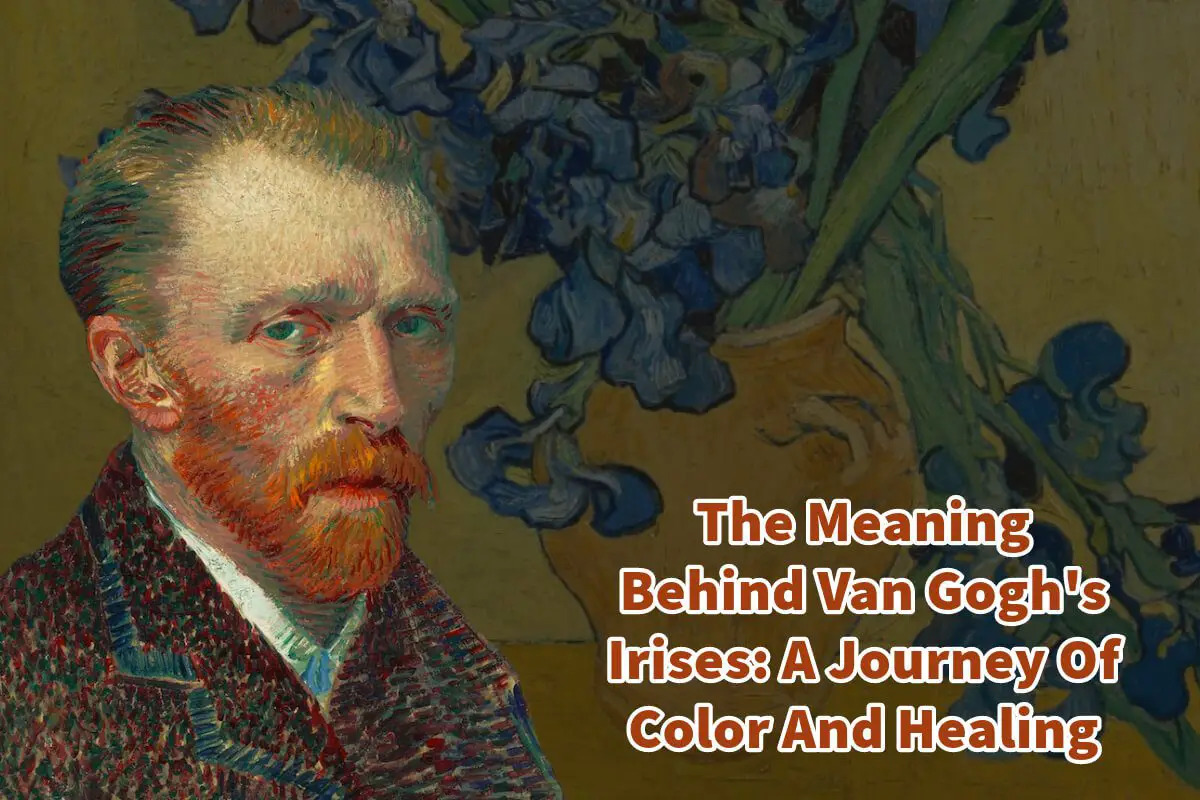Vincent Van Gogh has held a special place in my heart as one of my cherished artists. His unique style and how he plays with colors have always resonated with me.
Van Gogh’s exquisite rendering of flowers, including the iconic irises, particularly captivates my admiration. While the irises undoubtedly served as a study in color, I can’t help but wonder if they held a more profound significance for him—a visual lifeline tethering him to his sanity. Read on as we explore one of the meanings of the Irises.
Table of Contents
- The Meaning Behind Van Gogh’s Irises: A Journey Of Color And Healing
- A Study In Color And The Van Gogh Irises
- The Significance Of Irises And Van Gogh
- Frequently Asked Questions
- Related Questions
The Meaning Behind Van Gogh’s Irises: A Journey Of Color And Healing
Vincent Van Gogh, a Dutch artist renowned for his unique style and emotional intensity, left an indelible mark on the art world with his masterpieces. Among his many works, “Irises” is a testament to his artistry and struggles.

Painted during his time at the Saint Paul-de-Mausole asylum in Saint-Rémy-de-Provence, France, this floral still life holds more profound significance beyond its vibrant hues. Read on as we delve into the story of “Irises,” exploring its connection to Van Gogh’s mental state, his fascination with color, and its enduring impact on the art world.
A Study In Color And The Van Gogh Irises
“Irises” was born from Van Gogh’s desire to study color contrasts. Seeking to achieve a powerful visual impact, he juxtaposed the deep purple hues of the irises against a vibrant yellow background.
This stark contrast allowed the decorative forms of the flowers to stand out compellingly. The original intention was to emphasize the purple and pink flowers against the green stems and leaves, creating a harmony of colors that captivates the viewer.
Van Gogh’s fascination with color went beyond the surface; it was integral to his artistic philosophy. He aimed to convey emotions and sensations through his brushstrokes and color choices, enabling the viewer to experience the world as he did.
The irises served as a perfect subject for his exploration of color relationships, and the resulting painting is a testament to his mastery of the palette.
Why Did Vincent Van Gogh Do Color Studies?
Van Gogh’s fascination with color extended beyond mere artistic expression; it was an unquenchable thirst for understanding the intricacies of hues. He embarked on a profound study of colors, delving into color theory to unlock its secrets.
With a stack of books as his guide, he immersed himself in studying how colors interact and influence each other.
Complementary colors, those pairs that reside opposite each other on the color wheel, became a focal point of Van Gogh’s exploration. He recognized the dynamic interplay between these pairs—red and green, yellow and purple, blue and orange.
Through his diligent study, he discovered that these complementary colors can uniquely intensify one another, creating a visual synergy that captures the viewer’s attention.
For Van Gogh, this newfound knowledge wasn’t just theoretical; it was a revelation he could apply to his art. Armed with a deeper understanding of color relationships, he harnessed the power of complementary colors to create artworks that exuded vibrancy and depth.
His brushstrokes became a dance of colors as he skillfully manipulated these pairs to enhance the visual impact of his paintings.
Van Gogh’s dedication to learning was undeniable in his quest to unravel the mysteries of color. His commitment to studying color theory enriched his artistic palette and left an indelible mark on the art world.
Through his exploration of complementary colors, he elevated his works to new heights, infusing them with an unparalleled vibrancy that continues to captivate and inspire.
The Significance Of Irises And Van Gogh
The decision to paint irises during his time at the psychiatric hospital was not arbitrary. Van Gogh’s mental health struggles were well-documented, and he saw art as a form of therapy. “Irises” was painted only a month after he entered the asylum, making it his first artwork during his treatment.

He referred to the painting as “the lightning conductor for my illness,” highlighting its role in helping him cope with his inner turmoil.
The irises he painted were from the hospital’s garden, serving as a connection to the outside world. Observing and painting the flowers allowed him to channel his energy into his art, offering him a sense of purpose and a means of distraction from his inner struggles. Painting the irises was a lifeline, preventing him from succumbing to the darkness that often plagued him.
Symbolism And Impact Of Irises
The choice of irises as the subject of the painting carries symbolic weight. In Western culture, irises often symbolize hope, faith, and wisdom. Van Gogh’s selection of this flower may reflect his yearning for hope and stability during a tumultuous period.
The irises’ vibrant colors and graceful forms also stand in contrast to his inner turmoil, serving as a visual representation of his desire for tranquility and beauty.
As for the painting’s iconic status, it has captivated art enthusiasts and historians for generations. Its deep connection to Van Gogh’s struggles and his artistic exploration of color gives it a unique place in the art world. “Irises” showcases his technical prowess and provides a glimpse into his emotional state at that particular time.
The painting’s allure lies in its ability to bridge the gap between the artist’s inner and outer worlds, allowing viewers to engage with Van Gogh’s experiences on a profound level.

Vincent Van Gogh’s “Irises” is far more than a simple still life; it represents his journey through color and healing. Created during his time at the Saint Paul-de-Mausole asylum, the painting captures his exploration of color contrasts and his emotional connection to the world around him.
With their symbolic significance and vibrant hues, the irises are a conduit for his emotions and struggles. As “Irises” continues to captivate audiences and command attention in the art market, it stands as a testament to Van Gogh’s enduring legacy and ability to channel his pain into timeless works of art.
Frequently Asked Questions
Why did Van Gogh choose irises as a subject for his paintings?
Van Gogh had a profound fascination with nature, and irises, with their vibrant colors and intricate details, appealed to his artistic sensibilities. They became a recurring motif in his work, symbolizing beauty and nature.
Did Van Gogh have a specific reason for focusing on the irises in his art?
While irises served as a captivating subject for color exploration, some art historians suggest that Van Gogh found solace and healing in depicting these flowers. The act of painting them may have provided a therapeutic outlet for his struggles with mental health.
How did Van Gogh’s mental health influence his choice of subjects, including irises?
Van Gogh’s tumultuous mental health played a significant role in shaping his artistic choices. Irises, with their bold and expressive colors, might have served as a form of self-expression and a way for him to cope with his internal struggles.
Are there specific meanings associated with the colors Van Gogh used in his irises?
Van Gogh was known for his unique use of color. In the irises, each hue may carry symbolic meaning. For example, vibrant blues might represent calmness, while fiery reds could signify passion or turmoil. The interpretation can be subjective.
Did Van Gogh express any personal connection to the irises in his letters or writings?
Van Gogh often wrote letters to his family and friends, providing insights into his thoughts and emotions. Some of his correspondence mentions the irises, suggesting a personal connection and possibly an emotional attachment to this subject matter.
Were irises the only flowers Van Gogh painted, or did he explore other floral subjects?
While irises were a recurring theme, Van Gogh painted various flowers throughout his career, such as sunflowers and almond blossoms. Each had its own significance, and the choice of subject often correlated with his state of mind and emotions.
Can the irises be seen as a form of self-portraiture for Van Gogh?
Some art scholars speculate that Van Gogh’s choice of subjects, including irises, can be viewed as a form of self-portraiture. The flowers may symbolize different aspects of his personality, struggles, or moments of respite.
How did the art community perceive Van Gogh’s irises during his lifetime?
Van Gogh faced mixed reactions from the art community during his lifetime. Some appreciated his unique style and emotional depth, while others found his work unconventional. The significance of the irises as a symbol of healing might not have been widely recognized during his time.
Are there any known anecdotes or stories related to Van Gogh’s creation of the irises paintings?
While specific anecdotes related to the irises might not be extensively documented, Van Gogh’s letters and biographical accounts shed light on his artistic process and the emotional undercurrents that influenced his work.
How do art historians interpret the healing aspect of Van Gogh’s irises?
Interpretations vary among art historians, but some suggest that the repetitive act of painting irises could have functioned as a therapeutic ritual for Van Gogh, providing him with a sense of order and beauty amidst the chaos of his mental struggles.
Anita Louise Art is dedicated to art education, great artists, and inspiring others to find and create their art. We love art that uplifts and inspires. #ArtToMakeYouSmile! #ArtToMakeYouHappy!
If you are interested in seeing any of my art, you can find out more by clicking here. If you are interested in what inspires me and my paintings, you can discover more by clicking here.
We have a free newsletter and would love you to be part of our community; you can subscribe to the newsletter by clicking here. If you have any questions, I would be happy to talk to you at any time. You can reach me, Anita, by clicking here.
Subscribe to our Anita Louise Art YouTube Channel filled with great videos and information by clicking here.
Related Questions
What Did Leonardo da Vinci Contribute To The Renaissance?
Leonardo da Vinci made many contributions to the Renaissance in art, science, engineering, medicine, and architecture. He was a keen observer who wrote down a lot of what he discovered in his notebooks. His artistic techniques changed how artists painted and influenced many other Renaissance artists.
By clicking here, you can learn more by reading What Did Leonardo da Vinci Contribute To The Renaissance?.
What Technique Did Leonardo da Vinci Add To The Painter’s Toolbox?
Leonardo da Vinci added the Sfumato technique to the painter’s toolbox. The Sfumato technique is about an artist using a soft transition between the different colors and tones that the artist is using. Many artists, including Leonardo, use this technique on the faces they are painting to give them a more realistic feel.
By clicking here, you can learn more by reading What Technique Did Leonardo da Vinci Add To The Painter’s Toolbox?
Mona Lisa Painting And The Paris Louvre Museum
The Mona Lisa is one of the key paintings of the Louvre Museum. It is one of the most visited paintings in the world. The Mona Lisa is a painting studied, sang, written, and spoken about. There is still a mystery surrounding exactly who the Mona Lisa is and why Leonardo da Vinci painted it. This mystery adds to the allure of the painting.
By clicking here, you can learn more by reading Mona Lisa Painting And The Paris Louvre Museum.


